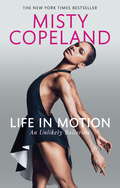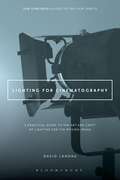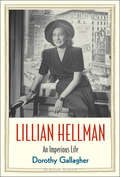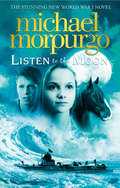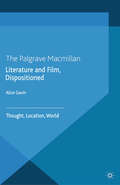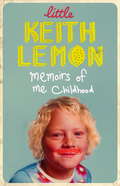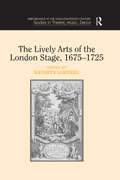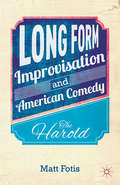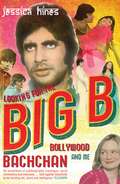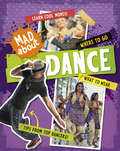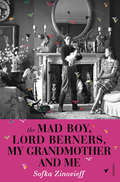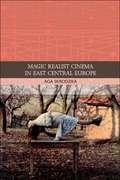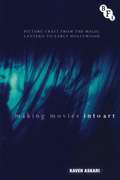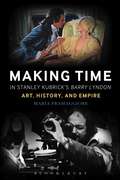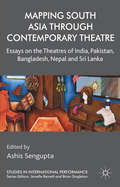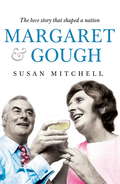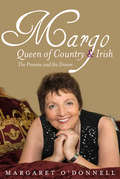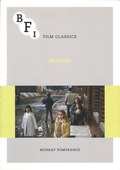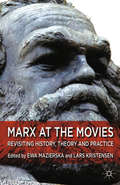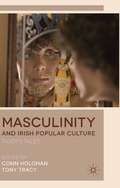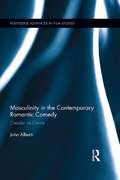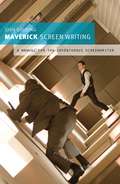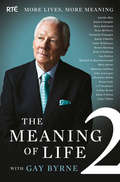- Table View
- List View
Life in Motion: An Unlikely Ballerina
by Misty CopelandWhen Misty Copeland first placed her hands on the ballet barre at an after-school community centre, no one expected the undersized, underprivileged and anxious thirteen-year-old to become one of America's most groundbreaking dancers. A true prodigy, she was attempting in months roles that take most dancers years to master. But when Misty became caught between the control and comfort she found in the world of ballet and the harsh realities of her own life, she had to choose to embrace both her identity and her dreams, and find the courage to be one of a kind.In this instant New York Times bestseller, Misty Copeland tells the story of her historic journey to become the first African-American principal ballerina at the prestigious American Ballet Theatre. With an insider's passion, Misty opens a window into the life of an artist who lives life centre stage, from behind the scenes at her first classes to her triumphant roles in some of the world's most iconic ballets. Life in Motion is a story of passion, identity and grace for anyone who has dared to dream of a different life.
Lighting for Cinematography: A Practical Guide to the Art and Craft of Lighting for the Moving Image (The CineTech Guides to the Film Crafts)
by David LandauWe can't shoot good pictures without good lighting, no matter how good the newest cameras are. Shooting under available light gives exposure, but lacks depth, contrast, contour, atmosphere and often separation. The story could be the greatest in the world, but if the lighting is poor viewers will assume it's amateurish and not take it seriously. Feature films and TV shows, commercials and industrial videos, reality TV and documentaries, even event and wedding videos tell stories. Good lighting can make them look real, while real lighting often makes them look fake.Lighting for Cinematography, the first volume in the new CineTech Guides to the Film Crafts series, is the indispensable guide for film and video lighting. Written by veteran gaffer and cinematographer David Landau, the book helps the reader create lighting that supports the emotional moment of the scene, contributes to the atmosphere of the story and augments an artistic style. Structured to mimic a 14 week semester, the chapters cover such things as lighting for movement, working with windows, night lighting, lighting the three plains of action and non-fiction lighting. Every chapter includes stills, lighting diagrams and key advice from professionals in the field, as well as lighting exercises to help the reader put into practice what was covered.www.lightingforcinematography.com
Lillian Hellman: An Imperious Life (Jewish Lives)
by Dorothy GallagherGlamorous, talented, audacious—Lillian Hellman knew everyone, did everything, had been everywhere. By the age of twenty-nine she had written The Children’s Hour, the first of four hit Broadway plays, and soon she was considered a member of America’s first rank of dramatists, a position she maintained for more than twenty-five years. Apart from her literary accomplishments—eight original plays and three volumes of memoirs—Hellman lived a rich life filled with notable friendships, controversial political activity, travel, and love affairs, most importantly with Dashiell Hammett. But by the time she died, the truth about her life and works had been called into question. Scandals attached to her name, having to do with sex, with money, and with her own veracity. Dorothy Gallagher confronts the conundrum that was Lillian Hellman—a woman with a capacity to inspire outrage as often as admiration. Exploring Hellman’s leftist politics, her Jewish and Southern background, and her famous testimony before the House Un-American Activities Committee, Gallagher also undertakes a new reading of Hellman’s carefully crafted memoirs and plays, in which she is both revealed and hidden. Gallagher sorts through the facts and the myths, arriving at a sharply drawn portrait of a woman who lived large to the end of her remarkable life and never backed down from a fight.
Listen to the Moon: Listen To The Moon, The Amazing Story Of Adolphus Tips, The Elephant In The Garden
by Michael MorpurgoThe stunning novel set during World War One from Michael Morpurgo, the nation’s favourite storyteller and multi-million copy bestseller.
Literature and Film, Dispositioned: Thought, Location, World (Language, Discourse, Society)
by Alice GavinLiterature and Film, Dispositioned looks to twentieth-century literature's encounter with film as a means to thinking about the locations of thought in literature and literature's location in the world. It includes readings of works by James Joyce, Henry James, and Samuel Beckett, whose Film (1965) forms a concluding focus.
Little Keith Lemon: Memoirs of me Childhood
by Keith LemonHave you ever wondered how Keith Lemon went from life as a young nipper in Leeds to being the strawberry blonde star of Celebrity Juice surrounded by bang tidy lasses? In this heart-warming and inspirational memoir, Keith reveals the story of his childhood, lifting the lid on all the experiences of northern youth that have led him to become the international ladies' man and national treasure he is today. In this hilarious memoir, Keith reminisces about his journey from baby to babe-magnet, delving deep into his past and his early years as an unbelievably talented youngster in Leeds (even before he became a professional sex symbol).
The Lively Arts of the London Stage, 1675–1725 (Performance in the Long Eighteenth Century: Studies in Theatre, Music, Dance)
by Kathryn LowerreUnlike collections of essays which focus on a single century or whose authors are drawn from a single discipline, this collection reflects the myriad performance options available to London audiences, offering readers a composite portrait of the music, drama, and dance productions that characterized this rich period. Just as the performing arts were deeply interrelated, the essays presented here, by scholars from a range of fields, engage in dialogue with others in the volume. The opening section examines a famous series of 1701 performances based on the competition between composers to set William Congreve's masque The Judgment of Paris to music. The essays in the central section (the 'mainpiece') showcase performers and productions on the London stage from a variety of perspectives, including English 'tastes' in art and music, the use of dance, the depiction of madness and masculinity in both spoken and musical performances, and genres and modes in the context of contemporary criticism and theatrical practice. A brief afterpiece looks at comic pieces in relation to satire, parody and homage. By bringing together work by scholars of music, dance, and drama, this cross-disciplinary collection illuminates the interconnecting strands that shaped a vibrant theatrical world.
The Lively Arts of the London Stage, 1675–1725 (Performance in the Long Eighteenth Century: Studies in Theatre, Music, Dance)
by Kathryn LowerreUnlike collections of essays which focus on a single century or whose authors are drawn from a single discipline, this collection reflects the myriad performance options available to London audiences, offering readers a composite portrait of the music, drama, and dance productions that characterized this rich period. Just as the performing arts were deeply interrelated, the essays presented here, by scholars from a range of fields, engage in dialogue with others in the volume. The opening section examines a famous series of 1701 performances based on the competition between composers to set William Congreve's masque The Judgment of Paris to music. The essays in the central section (the 'mainpiece') showcase performers and productions on the London stage from a variety of perspectives, including English 'tastes' in art and music, the use of dance, the depiction of madness and masculinity in both spoken and musical performances, and genres and modes in the context of contemporary criticism and theatrical practice. A brief afterpiece looks at comic pieces in relation to satire, parody and homage. By bringing together work by scholars of music, dance, and drama, this cross-disciplinary collection illuminates the interconnecting strands that shaped a vibrant theatrical world.
Long Form Improvisation and American Comedy: The Harold
by M. FotisLong form scenic improv began with the Harold. The comic philosophy of this form started an era of comedy marked by support, trust, and collaboration. This book tells of the Harold, beginning with the development of improv theatre, through the tensions and evolutions that led to its creation at iO, and to its use in contemporary filmmaking.
Looking for the Big B: Bollywood, Bachchan and Me
by Jessica Hines'Jessica,' he pronounced, 'you have known me for seven years. My life has changed seven times. You will never finish this book.'There is no reason why Amitabh Bachchan and I should appear in the same sentence. He is India's most legendary film star - a mixture of Clint Eastwood, Al Pacino and Elvis. In India where film stars are treated as gods, Bachchan is the über-god, the Big B. As for me, I am English, almost thirty, and not in the least bit famous. Yet here I am in Bombay about to start writing his story. How did I get here? Why did I get here? Can I pull it off? Bombay is mayhem and Bollywood is maddening. The Big B is strangely aloof, the magazines are full of lies, and no one is talking. I want to write a book that explodes the myths surrounding India's most famous man. But what will I find?
Mad About: Dance (PDF)
by Hachette BooksIf you're mad about dance, this book will help you make the most of your favourite hobby. Find out how to perfect your skills, whether you're dancing salsa, ballroom, tap or bhangra, and expand your abilities into taking part in dance shows and competitions.
The Mad Boy, Lord Berners, My Grandmother And Me: An Aristocratic Family, A High-society Scandal And An Extraordinary Legacy
by Sofka ZinovieffFaringdon House in Oxfordshire was the home of Lord Berners, composer, writer, painter, friend of Stravinsky and Gertrude Stein, a man renowned for his eccentricity – masks, practical jokes, a flock of multi-coloured doves – and his homosexuality. Before the war he made Faringdon an aesthete’s paradise, where exquisite food was served to many of the great minds, beauties and wits of the day. Since the early thirties his companion there was Robert Heber-Percy, twenty-eight years his junior, wildly physical, unscholarly, a hothead who rode naked through the grounds, loved cocktails and nightclubs, and was known to all as the Mad Boy. If the two men made an unlikely couple, at a time when homosexuality was illegal, the addition to the household in 1942 of a pregnant Jennifer Fry, a high society girl known to be ‘fast’, as Robert’s wife was simply astounding.After Victoria was born the marriage soon foundered (Jennifer later married Alan Ross). Berners died in 1950, leaving Robert in charge of Faringdon, aided by a ferocious Austrian housekeeper who strove to keep the same culinary standards in a more austere age. This was the world Sofka Zinovieff, Victoria’s daughter, a typical child of the sixties, first encountered at the age of seventeen. Eight years later, to her astonishment, Robert told her he was leaving her Faringdon House.Her book about Faringdon and its people is marvellously witty and full of insight, bringing to life a vanished world and the almost fantastical people who lived in it.
Magic Realist Cinema in East Central Europe: Magic Realist Cinema In East Central Europe (Traditions in World Cinema)
by Aga SkrodzkaMagic Realist Cinema is the first book-length critical analysis of magic realism in cinema.
Making Movies into Art: Picture Craft from the Magic Lantern to Early Hollywood (Cultural Histories of Cinema)
by Kaveh AskariFocusing on early cinema's relationship with the pictorial arts, this pioneering study explores how cinema's emergence was grounded in theories of picture composition, craft and arts education – from magic lantern experiments in 1890s New York through to early Hollywood feature films in the 1920s. Challenging received notions that the advent of cinema was a celebration of mechanisation and a radical rejection of nineteenth-century traditions of representation, Kaveh Askari instead emphasises the overlap between craft traditions and modernity in early film. Opening up valuable new perspectives on the history of film as art, Askari links American silent cinema with the practice of teaching the public how to appreciate fine art; charts its entrance into arts education via art schools and university film courses;shows how concepts of artistic production entered films through a material interest in the studio; and examines the way in which Maurice Tourneur and Rex Ingram made early art films by shaping an image of the film director around the idea of the fine artist.
Making Time in Stanley Kubrick's Barry Lyndon: Art, History, and Empire
by Maria PramaggioreConsidered by critics to be Stanley Kubrick's masterpiece, Barry Lyndon has suffered from scholarly and popular neglect. Maria Pramaggiore argues that one key reason that this film remains unappreciated, even by Kubrick aficionados, is that its transnational and intermedial contexts have not been fully explored. Taking a novel approach, she looks at the film from a transnational perspective -- as a foreign production shot in Ireland and an adaptation of a British novel by an American director about an Irish subject. Pramaggiore argues that, in Barry Lyndon, Kubrick develops his richest philosophical mediation on cinema's capacity to mediate the real and foregrounds film's relationship to other technologies of visuality, including painting, photography, and digital media. By combining extensive research into the film's source novel, production and reception with systematic textual analysis and an engagement with several key issues in contemporary academic debate, this work promises not only to make a huge impact in the field of Kubrick studies, but also in 1970s filmmaking, cultural history and transnational film practice.
Mapping South Asia through Contemporary Theatre: Essays on the Theatres of India, Pakistan, Bangladesh, Nepal and Sri Lanka (Studies in International Performance)
by Ashis SenguptaWhile remapping the region by examining enduring historical and cultural connections, this study discusses multiple traditions and practices of theatre and performance in five South Asian countries within their specific political and socio-cultural contexts.
Margaret & Gough: The love story that shaped a nation
by Susan MitchellThe Whitlams' wasn't just a love story - it was a dynamic and enduring partnership that shaped our nation.This is the compelling story of former Prime Minister Gough Whitlam, his wife Margaret and their 70-year relationship – personal and political, private and public. It is a story of how two extraordinary people, side by side, led the Australian nation into an exciting and turbulent new era.Gough had no small talk, Margaret had the gift of easy conversation. He was often ill-at-ease in company and preferred his books. She was warm, inclusive and jollied him along. He had a vicious tongue and a quick temper. She always tried to see the best in people. He knew everything about the ideology, history and heroes of the Labor movement. She trusted her instincts. They saw each other as equals and never hesitated to express their different viewpoints. He may have passed the laws that changed the nation, but she made it possible.This is a story of love, respect, struggle, success, failure, disappointment and resilience. It was the strength and endurance of this remarkable relationship that helped change our nation politically, culturally and socially. Neither Gough nor Margaret would have developed into what each became without the influence of the other. Through every major political change, every election campaign, every triumph and every loss, they stood together.Margaret and Gough takes us inside a partnership where the political was always personal and the personal was always political.'Mitchell succeeds in weaving together their lives against a backdrop of Gough's political career ... a fine dual biography' - The Australian'This sweeping, slightly idealised overview of their love, with a bit of political history thrown into the mix, is a lesson in commitment' - Daily Telegraph'Read about Gough the man who read romantic poems from Keats and Shelley to his new wife Margaret on their honeymoon in 1942' - Sunday Territorian
Margo: The Promise and the Dream
by Margaret O'DonnellThe official memoir of Margo O'Donnell, legendary Irish Country Music singer For fifty years now the name 'Margo' has been synonymous with everything that is positive and enriching in Country and Irish music. Blessed with an instantly recognisable voice, a voice unlike any other in the music business, the Donegal-born singer, despite the ever changing musical trends, has remained a star attraction, much loved by her fans, not only in Ireland and Britain, but also in the USA, Canada, Australia and other far destinations. She still possesses an infectious enthusiasm for performing and recording that she had in those very early days with The Keynotes. This is the story of her life, the successes and difficult times, in her own words.
Marnie (BFI Film Classics)
by Murray PomeranceA thrilling tale of anxiety and moral extremity, Marnie (1964) cemented Alfred Hitchcock's reputation as a master of suspense and the visual form. Murray Pomerance here ranges through the many tortuous and thrilling passages of Marnie, weaving critical discussion together with production history to reveal Marnie as a woman in flight from her self, her past, her love, and the eyes of surveilling others. Challenging many received opinions – including claims of technical sloppiness and the proposal that Marnie's marriage night is a 'rape scene' – Pomerance sheds new light on a film that can often be difficult to understand and accept on its own terms. Original and stimulating, this BFI Film Classic identifies Marnie as one of Hitchcock's masterpieces, highlights the film's philosophical and psychological sensitivity, and reveals its sharp-eyed understanding of American society and its mores.
Marx at the Movies: Revisiting History, Theory and Practice
by Lars KristensenMarx and the Moving Image approaches cinema from a Marxist perspective. It argues that the supposed 'end of history', marked by the comprehensive triumph of capitalism and the 'end of cinema', calls for revisiting Marx's writings in order to analyse film theories, histories and practices.
Masculinity and Irish Popular Culture: Tiger's Tales
by Conn Holohan Tony TracyMasculinity and Irish Popular Culture: Tiger's Tales is an interdisciplinary collection of essays by established and emerging scholars, analysing the shifting representations of Irish men across a range of popular culture forms in the period of the Celtic Tiger and beyond.
Masculinity in the Contemporary Romantic Comedy: Gender as Genre (Routledge Advances in Film Studies)
by John AlbertiThis volume addresses the growing obsolescence of traditional constructions of masculine identity in popular romantic comedies by proposing an approach that combines gender and genre theory to examine the ongoing radical reconstruction of gender roles in these films. Alberti creates a unified theory of gender role change in the movies that combines the insights of both poststructuralist gender and narrative genre theory, avoiding binary approaches to the study of gender representation. He establishes the current "crises" in both gender representation and genre development within romantic comedies as examples of experimentation and change towards narratives that feature more egalitarian and less essentialist constructions of gender.
Masculinity in the Contemporary Romantic Comedy: Gender as Genre (Routledge Advances in Film Studies #24)
by John AlbertiThis volume addresses the growing obsolescence of traditional constructions of masculine identity in popular romantic comedies by proposing an approach that combines gender and genre theory to examine the ongoing radical reconstruction of gender roles in these films. Alberti creates a unified theory of gender role change in the movies that combines the insights of both poststructuralist gender and narrative genre theory, avoiding binary approaches to the study of gender representation. He establishes the current "crises" in both gender representation and genre development within romantic comedies as examples of experimentation and change towards narratives that feature more egalitarian and less essentialist constructions of gender.
Maverick Screenwriting: A manual for the adventurous screenwriter
by Josh GoldingEvery film development executive says they're looking for original stories. Maverick Screenwriting will teach you how to play with advanced narrative techniques - time, logic and reality - that change the way we look at the world. Discover the techniques that give films like The Matrix, The Truman Show and Avatar an original twist. You will learn:the difference between plot-driven and concept-driven filmshow to play with time, reality and point-of-view in radical wayshow to emotionally connect with your audiencehow to create a 'Matrix' that will hold your story togetherhow to push your concept to the limit- how to tell a story that expresses the unique way you look at the world In Maverick Screenwriting, writers, development executives, producers and directors will all find inspiration and new approaches that will help your film project stand out.
The Meaning of Life 2 – More Lives, More Meaning with Gay Byrne: 20 Famous People Reflect on Life’s Big Questions
by Gay ByrneMore big questions – and more interesting answers – from Gay Byrne’s hugely popular RTÉ TV showWe all look for meaning in our lives and here twenty well-known public figures share what gives their lives meaning, prompting us to ponder the question ourselves and perhaps even find some answers.Following last year’s bestselling The Meaning of Life, Gay Byrne is back with more insightful discussions on the big themes that bind us all: childhood, love, faith, disbelief, morality, religion, grief.Based on his popular and long-running RTÉ TV show, The Meaning of Life 2 explores life’s big questions with an array of fascinating public figures, among them Ronan Keating, Micheál Ó Muircheartaigh, Ian Paisley and Imelda May.With Peter McVerry he ponders whether life is shaped by accidents or by the way people respond to accidents. Mary Robinson reveals the beliefs and values that fuel her formidable moral engine. Eamon Dunphy’s early experiences led him to believe that ‘everyone is magnificent in their own way’, and Edna O’Brien discusses her struggles with the Catholic Church after the infamous banning of The Country Girls.’There are many pearls of wisdom to be harvested from the human oysters featured here who share with me the beliefs, values, thoughts and experiences that have shaped, or been shaped by, their lives.’Gay ByrneThe Meaning of Life 2: Table of ContentsPreface by Gay ByrneImelda MayPeter McVerryMary RobinsonBrian CodyIan PaisleyJ. P. DonleavyEmily O’ReillyJohn LonerganRonan KeatingMaureen GaffneySean O’SullivanChristina NobleMicheál Ó MuircheartaighFionnula FlanaganColm TóibínMary ByrneColm WilkinsonCeline ByrneEdna O’BrienEamon DunphyFor each book sold, a donation will be made to The Peter McVerry Trust and The Christina Noble Children’s Foundation.
